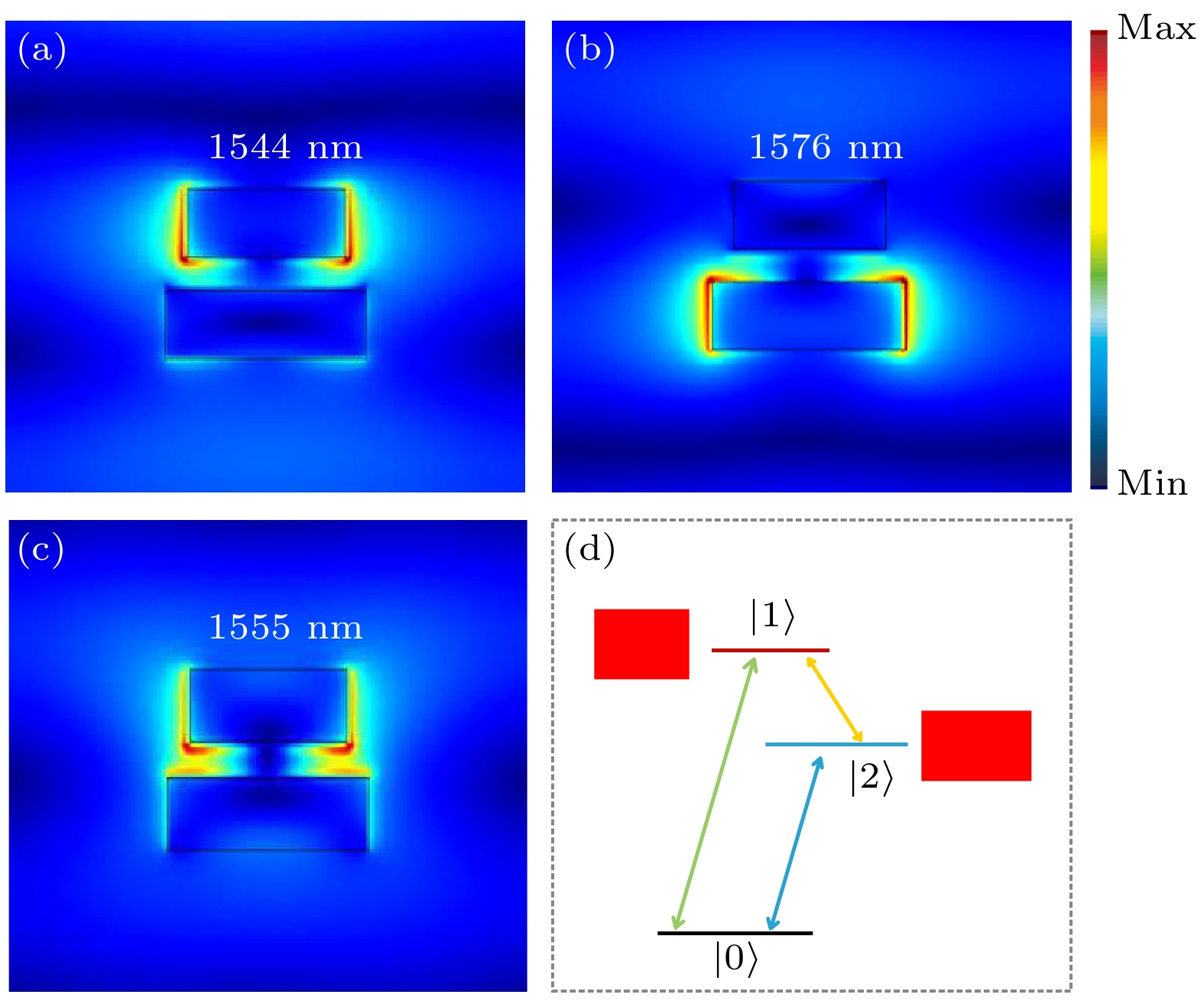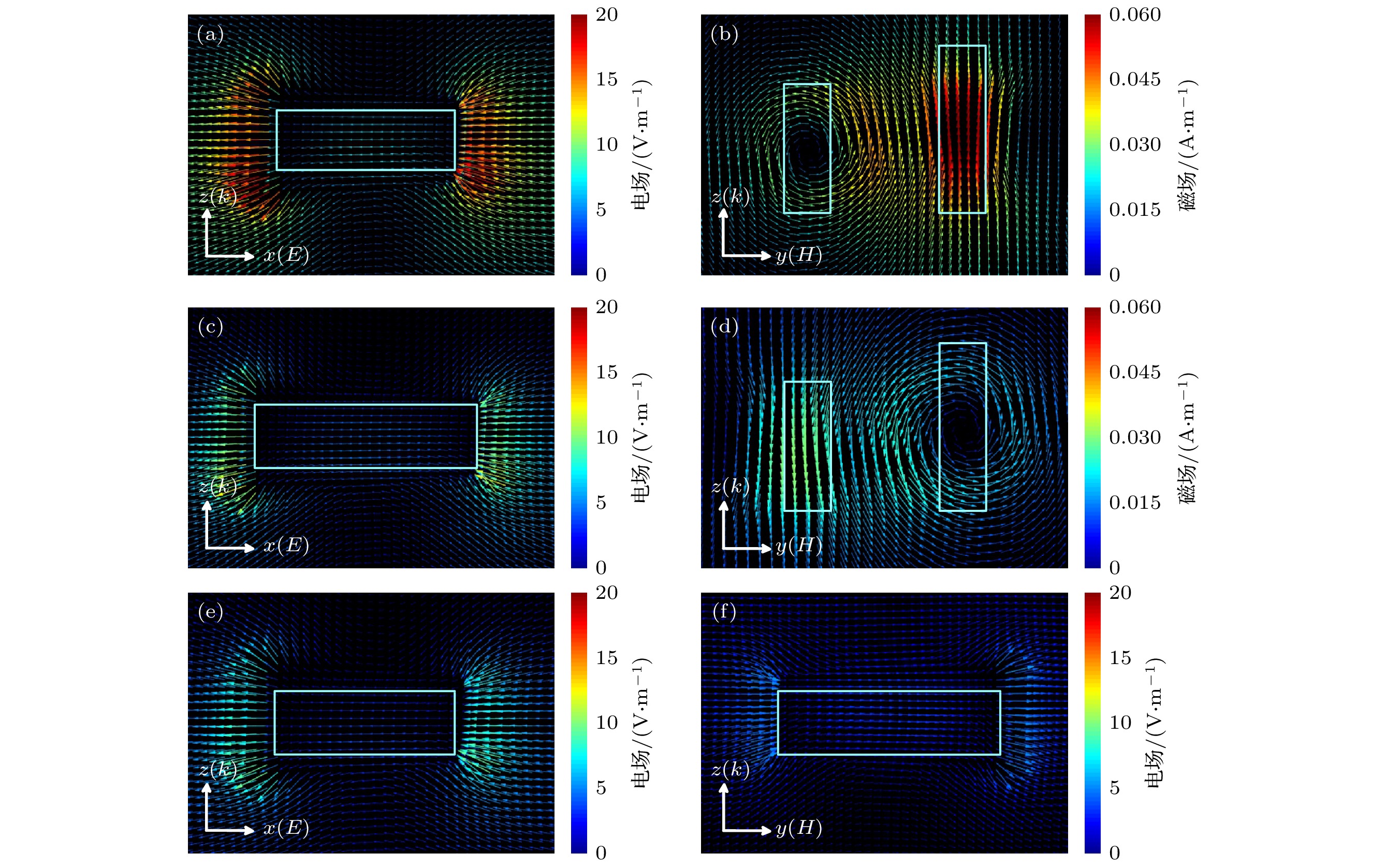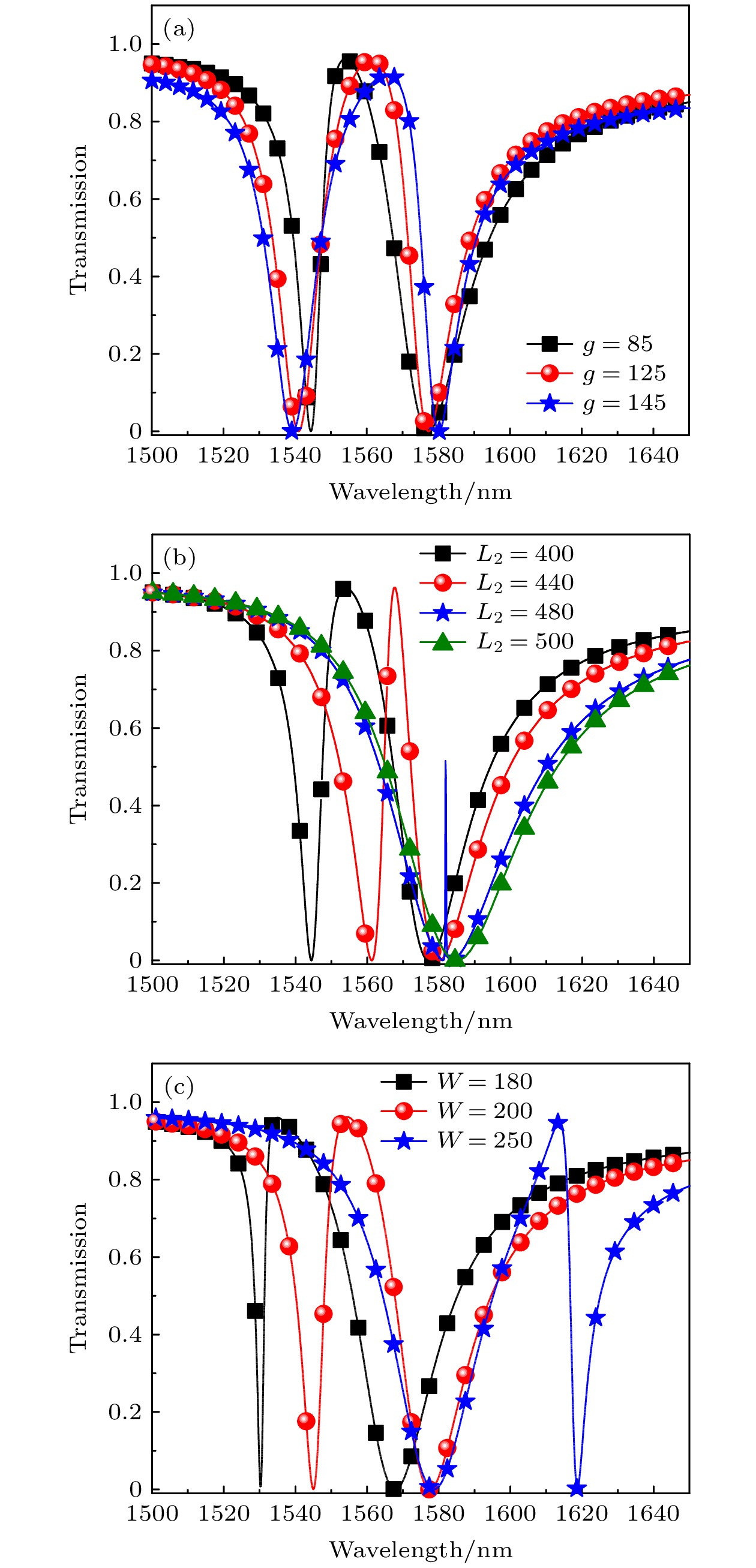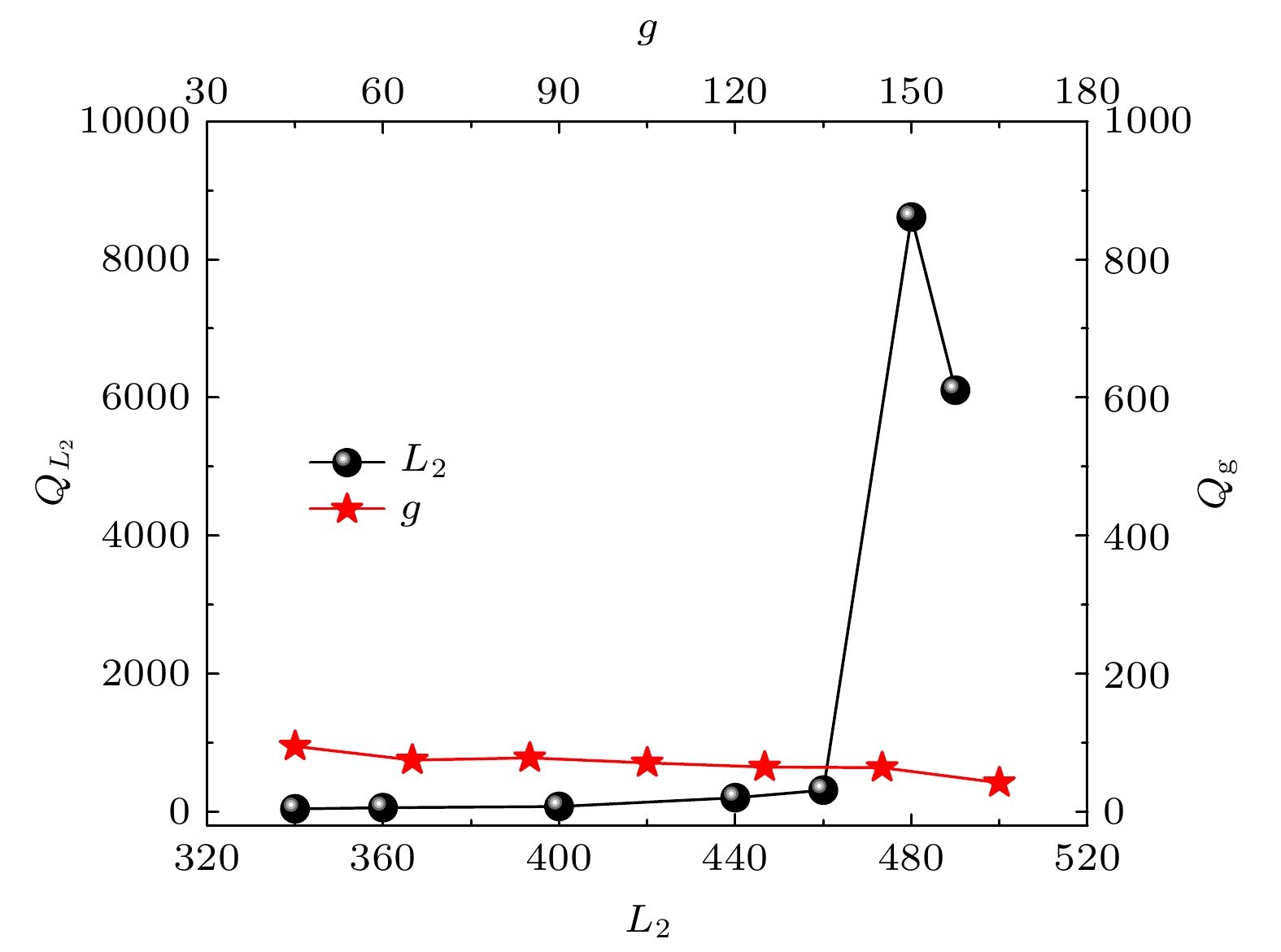-
本文设计了一种非对称结构的类电磁诱导透明超材料结构, 利用时域有限差分方法对其光学特性和类EIT效应进行了仿真分析, 建立了其耦合洛伦兹模型, 并对所设计超材料结构的类EIT效应进行了模拟分析. 结果表明: 利用两个长短不同的硅块明模和明模之间的耦合, 在1555 nm附近实现了类电磁诱导透明效应; 通过对该超材料的微结构参数进行优化, 实现了超高Q值(Q约为8616)的类EIT效应, 透射率可达96%; 通过调节硅块的长度以破坏超材料结构的非对称性, 实现了对类电磁诱导透明窗口的主动调控. 所设计的全介质超材料结构具有低损耗、易制备、主动可调控等优点, 在主动可调控的慢光器件、高灵敏的光学传感器、窄带滤波器等光学器件的设计中具有潜在的应用价值.The electromagnetically induced transparency (EIT), which is a result of destructive interference between different excitation paths in a three-energy-level atomic medium, makes opaque probe light transparent over a range of frequencies. As this EIT effect is usually accompanied with strong dispersion, it has potential applications such as slow light propagation, optical buffering, nonlinear optics, optical sensing, etc. However, for conventional quantum EIT effect which requires stable gas lasers and low temperature environment, the implementation of EIT in chip-scale applications is severely hampered by the scathing experimental requirements. Recently, the EIT-like effect in metamaterials, which are constructed by designing the artificial subwavelength functional elements and arranging the spatial sequences, attracts tremendous attention because of its advantages, such as room temperature manipulability, large bandwidth, and small sizes. In addition, the high-quality factor(Q) value obtained by EIT-like effect has great significance in designing the metamaterial-based devices. In this paper, we design an EIT-like metamaterial with such a structure. The unit cell of the proposed metamaterial is constructed by two asymmetric silicon blocks embedded on a silicon dioxide substrate. Meanwhile, we analyze its optical properties and EIT-like effects by using three-dimension (3D) FDTD method. Based on the coupled Lorentz model, the EIT-like effect of the designed metamaterial is investigated. Then, by employing the electric field distribution on the surface of the metamaterial, and combining with the three-level atomic system, the mechanism of the EIT-like effect is analyzed in detail. We find that the EIT-like effect in the proposed metamaterial has high Q value (Q ≈ 8616) and the high transmission (T = 96%). By changing the length of the silicon block to destroy the asymmetry of the metamaterial structure, an active tuning EIT-like effect is realized. Furthermore, the metamaterial structure has the advantages of low loss, easy preparation, and active-controllability. This study represents an innovative approach to designing the EIT-like metamaterial, which is expected to be useful for designing active tunable slow-light devices and highly sensitive optical sensors.
-
Keywords:
- all-dielectric metamaterials /
- electromagnetically induced transparency /
- coupling the Lorenz model
[1] Xia H, Sharpe S J, Merriam A J, Harris S E 1997 Phys. Rev. A 56 315
[2] Zhou J H, Zhang C X, Liu Q R, You J, Zheng X, Cheng X A, Jiang T 2020 Nanophotonics 9 2797
 Google Scholar
Google Scholar
[3] Wang Z, Yu B 2013 J. Appl. Phys. 113 101
 Google Scholar
Google Scholar
[4] 宁仁霞, 鲍婕, 焦铮 2017 66 100202
 Google Scholar
Google Scholar
Ning R X, Bao J, Jiao Z 2017 Acta Phys. Sin. 66 100202
 Google Scholar
Google Scholar
[5] Boller K J, Imamo L A, Harris S E 1991 Phys. Rev. Lett. 66 2593
 Google Scholar
Google Scholar
[6] Hau L V, Harris S E, Dutton Z, Behroozi C H 1999 Natrue 397 18
 Google Scholar
Google Scholar
[7] Marco P, Dario G, Liam O F, Claudio A L 2018 Opt. Express 26 8470
 Google Scholar
Google Scholar
[8] Lu H, Liu X M, Mao D 2012 Phys. Rev. A 85 053803
 Google Scholar
Google Scholar
[9] Chen M M, Xiao Z Y, Lu X J 2020 Carbon 159 273
 Google Scholar
Google Scholar
[10] Wang Q, Yu L, Gao H X, Chu S W, Wei P 2019 Opt. Express 27 35012
 Google Scholar
Google Scholar
[11] Li S X, Zhao H W, Han G J 2015 J. Elcetron. Sci. Technol. 13 117
 Google Scholar
Google Scholar
[12] Huang Y, Kenta N, Yuma T, Hiroaki M, Kazuhiro H, Yoshiaki K 2020 Sci. Rep. 10 20807
 Google Scholar
Google Scholar
[13] Liu H Q, Ren G B, Zhu B F, Li H S, Wu B L, Jian S S 2015 Opt. Commun. 353 189
 Google Scholar
Google Scholar
[14] Zhang S, Genov D A, Wang Y 2008 Phys. Rev. Lett. 101 218
[15] Niakan N, Askari M, Zakery A 2012 J. Opt. Soc. Am. B 29 2329
 Google Scholar
Google Scholar
[16] Liu C X, Liu P G, Bian L, Zhou Q H, Li G S, Liu H Q 2018 Opt. Commun. 410 17
 Google Scholar
Google Scholar
[17] Diao J Y, Han B X, Yin J, Li X J, Lang T T, Hong Z 2019 IEEE Photonics J. 11 4601110
 Google Scholar
Google Scholar
[18] Yang Y, Li J N, Li J, Huang J, Yan Q, Zhang Y T, Dai H T, Yao J Q 2020 Opt. Express 28 24047
[19] Hamed M N, Ehsan Z, Raheleh B J 2019 ENG SCI TECHN 22 862
 Google Scholar
Google Scholar
[20] Zhao Z, Wang H, Wang J 2020 China Commun. 17 180
[21] 韩张华 2008 博士学位论文(杭州: 浙江大学)
Han Z H 2008 Ph. D. Dissertstion (Hangzhou: Zhejiang University) (in Chinese)
[22] B.Tatian 1984 Appl. Opt. 23 4477
 Google Scholar
Google Scholar
[23] Han Z H, Bozhevolnyi S I 2011 Opt. Express 19 3251
 Google Scholar
Google Scholar
[24] Moritake Y, Kanamori Y, Hane K 2014 Opt. Lett. 39 4507
 Google Scholar
Google Scholar
-
图 4 ASADM发生Mie氏共振的物理机理 (a)短硅块在1544 nm处的电场矢量分布; (b)长、短硅块在1544 nm处的磁场分布; (c)长硅块在1576 nm处的电场矢量分布; (d)长、短硅块在1576 nm处的磁场矢量分布; (e)短硅块和(f)长硅块在1555 nm处的电场矢量分布
Fig. 4. Physical mechanism of Mie's resonance for the proposed ASADM: (a) Electric field vector distribution of the short silicon block at 1544 nm; (b) magnetic field distribution of long and short silicon blocks at 1544 nm; (c) electric field vector distribution of long silicon block at 1576 nm; (d) magnetic field vector distribution of long and short silicon blocks at 1576 nm; The electric field vector distribution of (e) short silicon block and (f) long silicon block at 1555 nm.
表 1 室温下, 不同非对称类EIT超材料的最大Q因子
Table 1. Maximum Q factors for different asymmetric EIT metamaterials at room temperature.
非对称结构超材料 最大 Q 因子 温度/K 铜(Cu) 54 300 金(Au) 7.34 300 硅(Si) 8616 300 -
[1] Xia H, Sharpe S J, Merriam A J, Harris S E 1997 Phys. Rev. A 56 315
[2] Zhou J H, Zhang C X, Liu Q R, You J, Zheng X, Cheng X A, Jiang T 2020 Nanophotonics 9 2797
 Google Scholar
Google Scholar
[3] Wang Z, Yu B 2013 J. Appl. Phys. 113 101
 Google Scholar
Google Scholar
[4] 宁仁霞, 鲍婕, 焦铮 2017 66 100202
 Google Scholar
Google Scholar
Ning R X, Bao J, Jiao Z 2017 Acta Phys. Sin. 66 100202
 Google Scholar
Google Scholar
[5] Boller K J, Imamo L A, Harris S E 1991 Phys. Rev. Lett. 66 2593
 Google Scholar
Google Scholar
[6] Hau L V, Harris S E, Dutton Z, Behroozi C H 1999 Natrue 397 18
 Google Scholar
Google Scholar
[7] Marco P, Dario G, Liam O F, Claudio A L 2018 Opt. Express 26 8470
 Google Scholar
Google Scholar
[8] Lu H, Liu X M, Mao D 2012 Phys. Rev. A 85 053803
 Google Scholar
Google Scholar
[9] Chen M M, Xiao Z Y, Lu X J 2020 Carbon 159 273
 Google Scholar
Google Scholar
[10] Wang Q, Yu L, Gao H X, Chu S W, Wei P 2019 Opt. Express 27 35012
 Google Scholar
Google Scholar
[11] Li S X, Zhao H W, Han G J 2015 J. Elcetron. Sci. Technol. 13 117
 Google Scholar
Google Scholar
[12] Huang Y, Kenta N, Yuma T, Hiroaki M, Kazuhiro H, Yoshiaki K 2020 Sci. Rep. 10 20807
 Google Scholar
Google Scholar
[13] Liu H Q, Ren G B, Zhu B F, Li H S, Wu B L, Jian S S 2015 Opt. Commun. 353 189
 Google Scholar
Google Scholar
[14] Zhang S, Genov D A, Wang Y 2008 Phys. Rev. Lett. 101 218
[15] Niakan N, Askari M, Zakery A 2012 J. Opt. Soc. Am. B 29 2329
 Google Scholar
Google Scholar
[16] Liu C X, Liu P G, Bian L, Zhou Q H, Li G S, Liu H Q 2018 Opt. Commun. 410 17
 Google Scholar
Google Scholar
[17] Diao J Y, Han B X, Yin J, Li X J, Lang T T, Hong Z 2019 IEEE Photonics J. 11 4601110
 Google Scholar
Google Scholar
[18] Yang Y, Li J N, Li J, Huang J, Yan Q, Zhang Y T, Dai H T, Yao J Q 2020 Opt. Express 28 24047
[19] Hamed M N, Ehsan Z, Raheleh B J 2019 ENG SCI TECHN 22 862
 Google Scholar
Google Scholar
[20] Zhao Z, Wang H, Wang J 2020 China Commun. 17 180
[21] 韩张华 2008 博士学位论文(杭州: 浙江大学)
Han Z H 2008 Ph. D. Dissertstion (Hangzhou: Zhejiang University) (in Chinese)
[22] B.Tatian 1984 Appl. Opt. 23 4477
 Google Scholar
Google Scholar
[23] Han Z H, Bozhevolnyi S I 2011 Opt. Express 19 3251
 Google Scholar
Google Scholar
[24] Moritake Y, Kanamori Y, Hane K 2014 Opt. Lett. 39 4507
 Google Scholar
Google Scholar
计量
- 文章访问数: 9618
- PDF下载量: 279
- 被引次数: 0














 下载:
下载:








